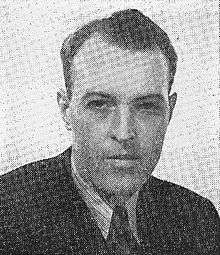George Hicks (broadcast journalist)
George Hicks (August 26, 1905 – March 17, 1965[1]) was an American broadcast journalist. He was a noted war correspondent, first with NBC and then with the Blue Network.[2]

Early years
Hicks was born in Tacoma, Washington, and graduated from George Washington University after attending several other colleges.[3]
Career
On December 27, 1934, NBC's Hicks interviewed Charles E. Apgar, a New Jersey radio amateur who made some of the first recordings of radio broadcasts during 1913–1915, including recordings of German spy messages during World War I.[4][5]
While based in London during World War II, Hicks recorded an on-the-scene report of the Normandy landings from the USS Ancon. It was broadcast on the night of June 6, 1944 over the American networks via a pool feed.[6][7] During the broadcast there were sounds of heavy bombardment. His voice was described as "modest" and "incapable of false drama" and was considered particularly well suited for covering the landings.[6] The New York World-Telegram called his broadcast "The greatest recording yet to come out of the war." [8]
Personal life
George Hicks was born in 1905. He died at the age of 59 and is buried in Flushing Cemetery, New York.[1] His only child, Robert Ivan Hicks, born in 1933 still lives in New York.
External link
References
- George Hicks at Find a Grave
- "Hollywood Star Walk - George Hicks". Los Angeles Times.
- DeLong, Thomas A. (1996). Radio Stars: An Illustrated Biographical Dictionary of 953 Performers, 1920 through 1960. McFarland & Company, Inc. ISBN 978-0-7864-2834-2. P. 129.
- "DOCUMENTING EARLY RADIO" Archived April 2, 2012, at the Wayback Machine, A Review of Existing Pre-1932 Radio Recordings, by Elizabeth McLeod
- "Interview with Charles E. Apgar". SONIC – Sound ONline Inventory Catalog. Library of Congress. Retrieved 28 December 2019.
Interview with Charles E. Apgar who for fourteen nights around June 18, 1915 recorded messages broadcast by a German owned and operated radio station in Sayville, Long Island. The U.S. government asked Apgar to do this because the station was broadcasting encoded information to Germany about American shipping for German submarines off-shore. Based on Apgar's recordings, the government seized the station on July 8, 1915. Apgar used his homemade radio receiver and an Edison cylinder phonograph to record the messages. During the interview he plays two of the original cylinders.
This audio cassette was copied from two 12-inch 78rpm aluminum discs which the Library does not own. - Erik, Barnouw (1968). A History of Broadcasting in the United States:Volume 2. Oxford University Press. p. 199. ISBN 0-19-500475-2.
- "George Hicks and the network coverage of the Pool Broadcast of D-Day", Radio Days
- Broadcasting, Volume 26. Broadcasting Publications. 1944. p. 9.